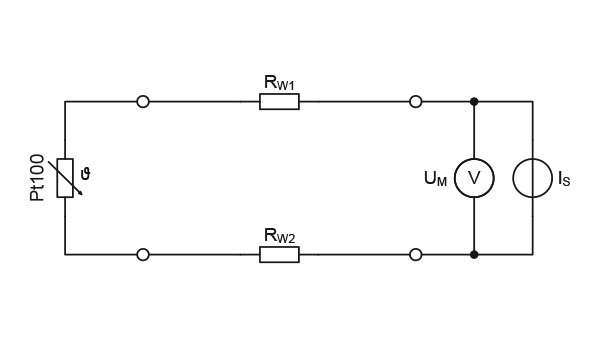The temperature sensors in the broad Baumer portfolio meet all industry requirements and are compatible with process connections of international standards. Thanks to their building block architecture you will always find the right product for your application. Easily and with the highest level of flexibility.
Technology
Resistance thermometer
In resistance thermometers, measurement is based on the change in resistance of precious metals under temperature influence. Since every metal has a specific resistance characteristic, and dU and dR demonstrate approximately proportional (linear) behavior in precious metals such as platinum, the change in resistance dR can be deduced from the voltage change dU by supplying a constant measurement current. The measurement current is selected as low as possible to minimize self-heating of the resistance thermometer.
Thermocouple
Thermocouples behave according to the Seebeck effect which describes the production of a charge shift on a conductor when there is a temperature difference along it. The magnitude of the charge shift depends on the material and its electric properties. If there is a conductive connection between two conductors made of different materials on one side and a temperature difference exists there, voltage is applied at the open ends. This voltage depends on the temperature difference and the electric properties of both materials; since they and their characteristics are known, the temperature can be measured via the voltage.
Resistance temperature sensors are classified according to DIN EN 60751
The first two letters refer to the employed precious metal. The following digit specifies the electrical resistance in ohm at 0 °C.
The classes defined in DIN EN 60751 define the permissible deviation and the measuring range in which these deviations are to be observed.
- Class A: +/- (0.15+0.002 x [ t ] ) °C; for platinum temperature sensors between -200 and +650 °C
- Class AA: +/- 1/3 x (0.3+0.005 x [ t ] ) °C; for platinum temperature sensors between -200 and +850 °C
- Class B: +/- (0.3 +0.005 x [ t ] ) °C; for platinum temperature sensors between -200 and +850 °C
- Class 1/6 B: +/- 1/6 x (0.3 +0.005 x [ t ] ) °C; for platinum temperature sensors between -200 and +850 °C
BCID system process connections
Baumer sensors are suitable for virtually every process connection. Thanks to our more than 40 connection types, you do not need to modify your plant design in any way. The Baumer Connection Identifier (BCID) is a convenient and safe system for identifying the right process adapter in order to integrate your Baumer sensor in the respective application.
Accuracy Pt100 classes (according to DIN/EN/IEC 60751)


Pt100 signal transmission
Temperature transmitter FlexTop
Baumer offers a wide range of temperature transmitters that convert either an RTD or T/ C signal into analog or digital communication (HART). The portfolio comprises transmitters for in-head and rail mounting.
Configurable sensing elements from the FlexTop family
RTD: Abbreviation for “Resistance Temperature Detector”, a temperature-variable resistor. In addition to the standard platinum-based Pt100 and Pt1000 types, others based on copper or nickel can be configured with FlexTop.
Pt100: RTD from a thin platinum layer with 100 Ohm at 0 °C (32 °F). The calibration curve and accuracy classes are defined in DIN/EN/IEC 60751, with the change in resistance being largely linear at 0.38%/K. With FlexTop, these and other calibration curves can be configured (by the a-value).
Pt1000: RTD analog as with the Pt100 , but with 1000 Ohm at 0 °C (32 °F) and thus ten times the absolute change in resistance. Compared to the Pt100 and while having applied the 2-wire technology the same offset results after 10 times the wire length. On the other hand, increased attention must be paid to insulation faults, for example due to moisture infiltration. The Pt100 may be more robust in this respect.
Thermocouples (T/C): Two wires made of different metallic materials are connected to each other. At the open ends, the “thermoelectric voltage” is measured (Seebeck effect); depending on the material combination and temperature, this is in the millivolt range. The purely metallic sensing elements allow the measurement of very high temperatures up to more than 1800 °C (3300 °F). If the thermocouple is extended, a “compensating line” made of the same material is required. Otherwise the cold junction compensation is distorted. Generally speaking, the thermocouple (small voltage signal and cold junction temperature measurement) involves more work than in the case of resistor elements.
Unit Conversions







